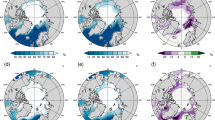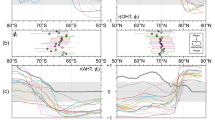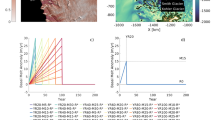Abstract
Arctic sea ice has been declining over past several decades with the largest ice loss occurring in summer. This implies a strengthening of the sea ice seasonal cycle. Here, we examine global ocean salinity response to such changes of Arctic sea ice using simulations wherein we impose a radiative heat imbalance at the sea ice surface, inducing a sea ice decline comparable to the observed. The imposed perturbation leads to enhanced seasonal melting and a rapid retreat of Arctic sea ice within the first 5–10 years. We then observe a gradual freshening of the upper Arctic ocean that continues for about a century. The freshening is most pronounced within the central Arctic, including the Beaufort gyre, and is attributed to excess surface freshwater associated with the stronger seasonal sea ice melting, as well as a greater upper-ocean freshwater storage due to changes in ocean circulation. The freshening of the Nordic Seas can also occur via a distillation-like process in which denser saline waters with increased salinity are exported to the subtropical/tropical North Atlantic by meridional overturning circulation. Thus, enhanced seasonal sea ice melting in a warmer climate can lead to a persistent Arctic freshening with large impacts on the global salinity distribution.














Similar content being viewed by others
Data availability
The observational record for sea ice area provided by the National Snow and Ice Data Center (NSIDC) is available at https://nsidc.org/data/NSIDC-0051/versions/1.
Materials availability
Sea ice volume from Pan-Arctic Ice Ocean Modeling and Assimilation System (PIOMAS) can be accessed at http://psc.apl.uw.edu/research/projects/arctic-sea-ice-volume-anomaly/data/.
Code availability
Additional model data and code can be requested from the authors.
Change history
02 August 2022
A Correction to this paper has been published: https://doi.org/10.1007/s00382-022-06433-8
References
Aagaard K, Carmack EC (1989) The role of sea ice and other fresh water in the Arctic circulation. J Geophys Res Oceans 94:14485–14498. https://doi.org/10.1029/JC094iC10p14485
Bamber J, van den Broeke M, Ettema J et al (2012) Recent large increases in freshwater fluxes from Greenland into the North Atlantic: FRESHWATER INTO THE NORTH ATLANTIC. Geophys Res Lett. https://doi.org/10.1029/2012GL052552
Bitz CM, Gent PR, Woodgate RA et al (2006) The influence of sea ice on ocean heat uptake in response to increasing CO2. J Clim 19:2437–2450. https://doi.org/10.1175/JCLI3756.1
Blackport R, Kushner PJ (2016) The transient and equilibrium climate response to rapid summertime sea ice loss in CCSM4. J Clim 29:401–417. https://doi.org/10.1175/JCLI-D-15-0284.1
Cavalieri DJ, Parkinson CL (2008) Antarctic sea ice variability and trends, 1979–2006. J Geophys Res 113:C07004. https://doi.org/10.1029/2007JC004564
Cohen J, Screen JA, Furtado JC et al (2014) Recent Arctic amplification and extreme mid-latitude weather. Nat Geosci 7:627–637. https://doi.org/10.1038/ngeo2234
Cornish SB, Kostov Y, Johnson HL, Lique C (2020) Response of Arctic freshwater to the Arctic oscillation in coupled climate models. J Clim 33:2533–2555. https://doi.org/10.1175/JCLI-D-19-0685.1
Deser C, Tomas RA, Sun L (2015) The role of ocean-atmosphere coupling in the zonal-mean atmospheric response to Arctic sea ice loss. J Clim 28:2168–2186. https://doi.org/10.1175/JCLI-D-14-00325.1
Eisenman I, Schneider T, Battisti DS, Bitz CM (2011) Consistent changes in the sea ice seasonal cycle in response to global warming. J Clim 24:5325–5335. https://doi.org/10.1175/2011JCLI4051.1
Fischer EM, Knutti R (2015) Anthropogenic contribution to global occurrence of heavy-precipitation and high-temperature extremes. Nature Clim Change 5:560–564. https://doi.org/10.1038/nclimate2617
Goldstein MA, Lynch AH, Zsom A et al (2018) The step-like evolution of Arctic open water. Sci Rep 8:16902. https://doi.org/10.1038/s41598-018-35064-5
Haine TWN, Curry B, Gerdes R et al (2015) Arctic freshwater export: status, mechanisms, and prospects. Global Planet Change 125:13–35. https://doi.org/10.1016/j.gloplacha.2014.11.013
Holland MM, Bailey DA, Briegleb BP et al (2012) Improved sea ice shortwave radiation physics in CCSM4: the impact of melt ponds and aerosols on Arctic sea ice*. J Clim 25:1413–1430. https://doi.org/10.1175/JCLI-D-11-00078.1
Johnson HL, Cornish SB, Kostov Y et al (2018) Arctic ocean freshwater content and its decadal memory of sea-level pressure. Geophys Res Lett 45:4991–5001. https://doi.org/10.1029/2017GL076870
Kwok R, Rothrock DA (2009) Decline in Arctic sea ice thickness from submarine and ICESat records: 1958–2008: ARCTIC SEA ICE THICKNESS. Geophys Res Lett. https://doi.org/10.1029/2009GL039035
Lambert E, Nummelin A, Pemberton P, Ilıcak M (2019) Tracing the imprint of river runoff variability on Arctic water mass transformation. J Geophys Res Oceans 124:302–319. https://doi.org/10.1029/2017JC013704
Li H, Fedorov A, Liu W (2021) AMOC stability and diverging response to Arctic sea ice decline in two climate models. J Clim 34:5443–5460. https://doi.org/10.1175/JCLI-D-20-0572.1
Liu W, Fedorov AV (2019) Global impacts of Arctic sea ice loss mediated by the atlantic meridional overturning circulation. Geophys Res Lett 46:944–952. https://doi.org/10.1029/2018GL080602
Liu W, Fedorov A, Sévellec F (2018) The mechanisms of the Atlantic Meridional Overturning Circulation slowdown induced by Arctic sea ice decline. J Clim. https://doi.org/10.1175/JCLI-D-18-0231.1
Neale RB, Gettelman A, Park S et al (2012) Description of the NCAR community atmosphere model (CAM 5.0). In: Zhao et al (eds)Technical note NCAR/TN-486+STR. National Center for Atmospheric, AEROSOL FIE SIMULATED BY CAMS L08806, pp 2009–038451
Nummelin A, Ilicak M, Li C, Smedsrud LH (2016) Consequences of future increased Arctic runoff on Arctic Ocean stratification, circulation, and sea ice cover. J Geophys Res Oceans 121:617–637. https://doi.org/10.1002/2015JC011156
Oudar T, Sanchez-Gomez E, Chauvin F et al (2017) Respective roles of direct GHG radiative forcing and induced Arctic sea ice loss on the Northern Hemisphere atmospheric circulation. Clim Dyn 49:3693–3713. https://doi.org/10.1007/s00382-017-3541-0
Pemberton P, Nilsson J (2016) The response of the central Arctic Ocean stratification to freshwater perturbations. J Geophys Res Oceans 121:792–817. https://doi.org/10.1002/2015JC011003
Proshutinsky A, Krishfield R, Timmermans M-L et al (2009) Beaufort Gyre freshwater reservoir: state and variability from observations. J Geophys Res Oceans. https://doi.org/10.1029/2008JC005104
Rabe B, Karcher M, Kauker F et al (2014) Arctic Ocean basin liquid freshwater storage trend 1992–2012. Geophys Res Lett 41:961–968. https://doi.org/10.1002/2013GL058121
Schweiger A, Lindsay R, Zhang J et al (2011) Uncertainty in modeled Arctic sea ice volume. J Geophys Res 116:C00D06. https://doi.org/10.1029/2011JC007084
Scinocca JF, Reader MC, Plummer DA et al (2009) Impact of sudden Arctic sea-ice loss on stratospheric polar ozone recovery. Geophys Res Lett 36:L24701. https://doi.org/10.1029/2009GL041239
Serreze MC, Barrett AP, Slater AG et al (2006) The large-scale freshwater cycle of the Arctic. J Geophys Res 111:C11010. https://doi.org/10.1029/2005JC003424
Serreze M, Barrett A, Stroeve J et al (2009) The emergence of surface-based Arctic amplification. Cryosphere 3:11–19. https://doi.org/10.5194/tc-3-11-2009
Sévellec F, Fedorov AV, Liu W (2017) Arctic sea-ice decline weakens the Atlantic Meridional Overturning Circulation. Nature Clim Change 7:604–610. https://doi.org/10.1038/nclimate3353
Shu Q, Qiao F, Song Z et al (2018) Projected freshening of the Arctic Ocean in the 21st century. J Geophys Res Oceans. https://doi.org/10.1029/2018JC014036
Smith R, Jones P, Briegleb B et al (2010) The parallel ocean program (POP) reference manual ocean component of the community climate system model (CCSM) and community earth system model (CESM). Rep LAUR-01853 141:1–140
Stigebrandt A (1981) A model for the thickness and salinity of the upper layer in the Arctic Ocean and the relationship between the ice thickness and some external parameters. J Phys Oceanogr 11:1407–1422. https://doi.org/10.1175/1520-0485(1981)011%3c1407:AMFTTA%3e2.0.CO;2
Stroeve J, Holland MM, Meier W et al (2007) Arctic sea ice decline: faster than forecast: ARCTIC ICE LOSS-FASTER THAN FORECAST. Geophys Res Lett. https://doi.org/10.1029/2007GL029703
Sun L, Alexander M, Deser C (2018) Evolution of the global coupled climate response to Arctic Sea ice loss during 1990–2090 and Its contribution to climate change. J Clim 31:7823–7843. https://doi.org/10.1175/JCLI-D-18-0134.1
Timmermans M-L, Toole J, Krishfield R (2018) Warming of the interior Arctic Ocean linked to sea ice losses at the basin margins. Sci Adv 4:eaat6773. https://doi.org/10.1126/sciadv.aat6773
Uttal T, Curry JA, McPhee MG et al (2002) Surface heat budget of the Arctic Ocean. Bull Am Meteor Soc 83:255–276. https://doi.org/10.1175/1520-0477(2002)083%3c0255:SHBOTA%3e2.3.CO;2
Wang K, Deser C, Sun L, Tomas RA (2018a) Fast response of the tropics to an abrupt loss of Arctic sea ice via ocean dynamics. Geophys Res Lett 45:4264–4272. https://doi.org/10.1029/2018GL077325
Wang Q, Wekerle C, Danilov S et al (2018b) Arctic sea ice decline significantly contributed to the unprecedented liquid freshwater accumulation in the beaufort gyre of the Arctic Ocean. Geophys Res Lett 45:4956–4964. https://doi.org/10.1029/2018GL077901
Winton M (2006) Amplified Arctic climate change: What does surface albedo feedback have to do with it? Geophys Res Lett. https://doi.org/10.1029/2005GL025244
Woodgate RA, Weingartner TJ, Lindsay R (2012) Observed increases in Bering Strait oceanic fluxes from the Pacific to the Arctic from 2001 to 2011 and their impacts on the Arctic Ocean water column. Geophys Res Lett 39:2012GL054092. https://doi.org/10.1029/2012GL054092
Zhang J, Rothrock DA (2003) Modeling global sea ice with a thickness and enthalpy distribution model in generalized curvilinear coordinates. Mon Weather Rev 131:17
Acknowledgements
We are grateful to Wei Liu (University of California Riverside) for making available the model output for analysis. Support from the Yale University High Performance Computing center is also acknowledged.
Funding
This study is supported by grants from NSF (OCE-1756682, OPP-1741847), the ARCHNGE project of the “Make our planet great again” program (CNRS, France), and the Guggenheim fellowship to AVF. H. Li is supported by the Regional and Global Climate Modeling Program (RGCM) of the U.S. Department of Energy's Office of Biological & Environmental Research (BER) via National Science Foundation IA 1844590.
Author information
Authors and Affiliations
Contributions
HL performed the calculations and analysis as well as produced the Figures. Both authors discussed the results and contributed to writing the manuscript. AV Fedorov directed this work with contributions from HL.
Corresponding author
Ethics declarations
Conflict of interest
The authors declare that they have no conflict of interest.
Additional information
Publisher's Note
Springer Nature remains neutral with regard to jurisdictional claims in published maps and institutional affiliations.
Supplementary Information
Below is the link to the electronic supplementary material.
Rights and permissions
Springer Nature or its licensor (e.g. a society or other partner) holds exclusive rights to this article under a publishing agreement with the author(s) or other rightsholder(s); author self-archiving of the accepted manuscript version of this article is solely governed by the terms of such publishing agreement and applicable law.
About this article
Cite this article
Li, H., Fedorov, A.V. Persistent freshening of the Arctic Ocean and changes in the North Atlantic salinity caused by Arctic sea ice decline. Clim Dyn 57, 2995–3013 (2021). https://doi.org/10.1007/s00382-021-05850-5
Received:
Accepted:
Published:
Issue Date:
DOI: https://doi.org/10.1007/s00382-021-05850-5




